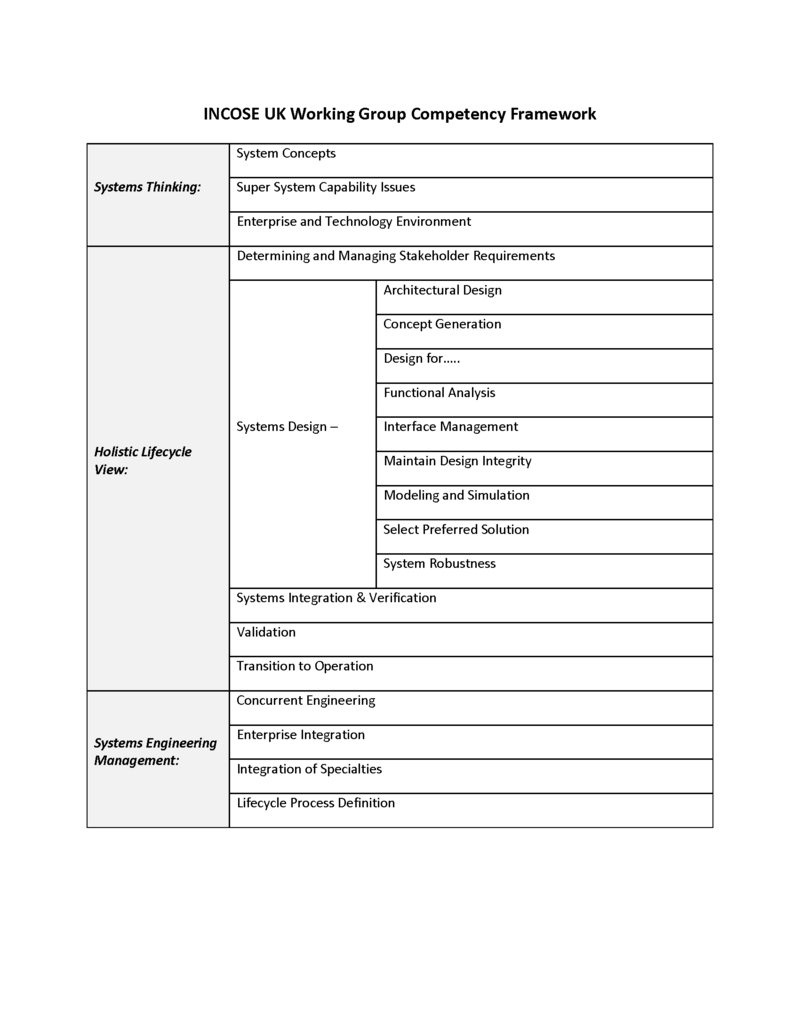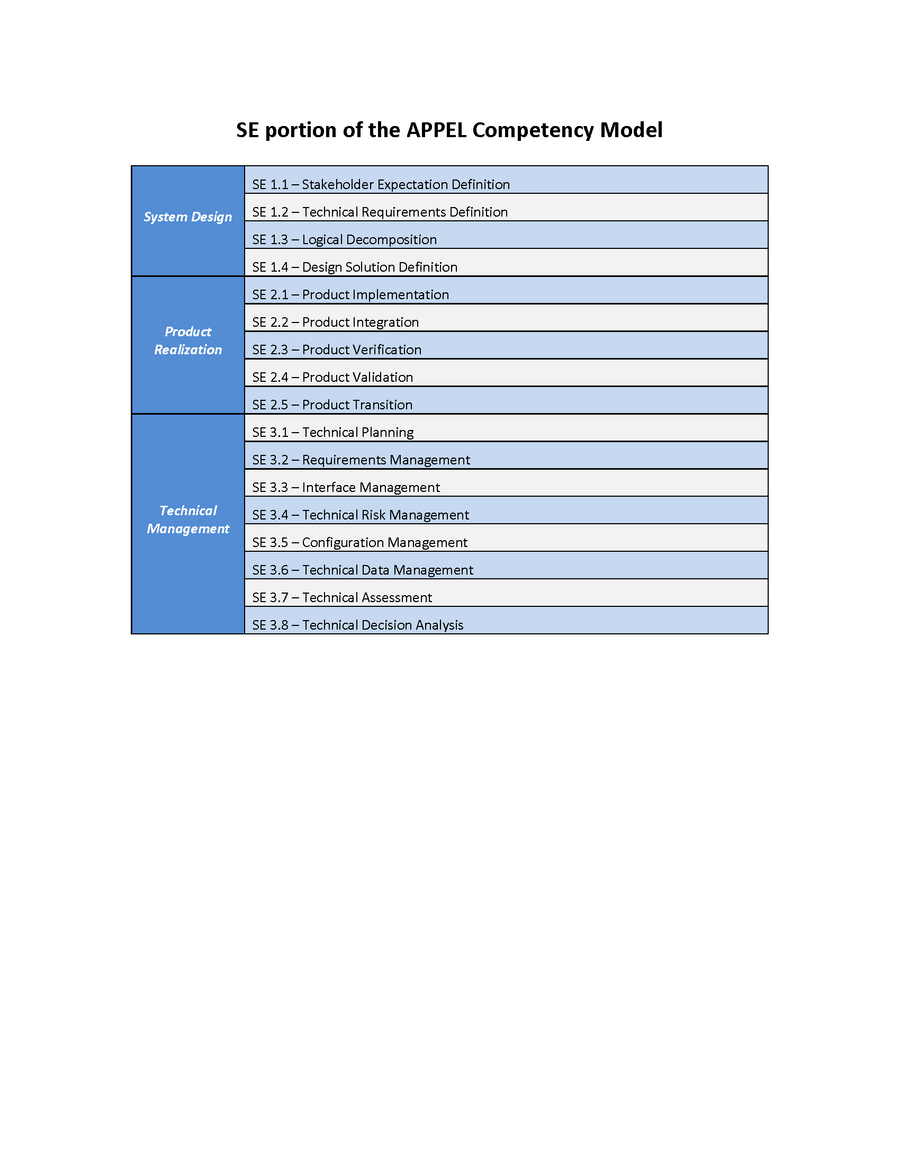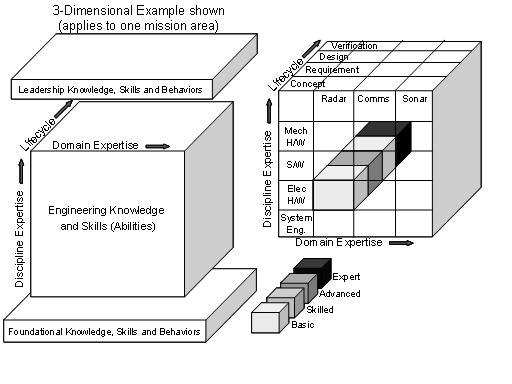Roles and Competencies
Part of Enabling Individuals to Perform Systems Engineering is understanding systems engineering roles and competencies. Within an enterprise, systems engineering responsibilities are allocated to individuals, teams, and possibly businesses through the definition of systems engineering roles. For an individual, a set of competencies enables the fulfillment of the assigned systems engineering role.
Systems engineering (SE) competency is built from knowledge, skills, abilities, and attitudes (KSAA). These are developed through education and experience. Traditionally, systems engineering competencies have been developed primarily through experience. Recently, education has taken on a much greater role in the development of systems engineering competencies. SE competency must be viewed through the relationship to the systems life cycle, the system engineering discipline, and the domain where the engineer practices systems engineering.
SE Competency Models
In order to better understand the set of competencies required for systems engineering, many systems engineering competency models have been developed. Individual competency models are typically used for one three purposes:
- Recruitment and Selection – Competencies define categories for behavioral-event interviewing, increasing the validity and reliability of selection and promotion decisions;
- Human Resources Planning and Placements – Competencies can be used to identify individuals to fill specific positions and/or identify gaps in key competency areas; or
- Education, Training, and Development – Explicit competency models let employees know what behaviors are valued within their organization. Curriculum and interventions can be designed around desired competencies.
Application
To date, a consensus on SE competencies and competency models has not yet emerged. Many of the SE competency models available were developed for specific contexts or for specific organizations, and these models are useful within these contexts. However, users of models should be aware of the development method and context for the competency model they plan to use, since the primary competencies for one organization might be different than those for another organization. These models may also include an added dimension for the domain and mission areas where the systems are applied. Each competency model typically includes a set of applicable competencies along with a scale for assessing the level of proficiency; more information can be found in the article Assessing Individuals.
Note that the long lists of competencies on existing models are not always intended to be fulfilled by one individual, but by groups of individuals. Team competency is not a direct summation of the competency of the individuals on the team, since team dynamics and interpersonal issues complicate the combination of individual competencies at the team level. The Enabling Teams to Perform Systems Engineering and Enabling Businesses and Enterprises to Perform Systems Engineering knowledge areas address grouping of individuals to fulfill the elements of the SE competency models.
Existing SE Competency Models
Though many organizations have internal systems engineering competency models, there are several published SE competency models which can be used for reference. These include:
- The International Council on Systems Engineering (INCOSE) UK Advisory Board model published in 2005 (Cowper and et al. 2005), and updated in 2010 (INCOSE 2010b)
- The MITRE SE Competency model published in 2007 (MITRE 2007, 1-12)
- The SPRDE-SE/PSE model (DAU 2010); and
- The APPEL model (Menrad and Lawson 2008).
Other models and lists of traits include: (Hall 1962), (Frank 2000, 2002, 2006), (Kasser and et al. 2009), (Squires and et al. 2011), and (Armstrong and et al. 2011). Ferris (2010) provides a summary and evaluation of the existing frameworks for personnel evaluation and for defining SE education. SE competencies can also be inferred from standards such as ISO-15288 (ISO/IEC/IEEE 15288) and from sources such as the INCOSE Systems Engineering Handbook (INCOSE 2010a), the INCOSE Systems Engineering Certification Program, and CMMI criteria (SEI 2007). Table 1 shows multiple SE competency definitions that have been developed to date, along with characteristics of each of these. Each model was developed for a unique purpose within a specific context and validated in a particular way. It is important to understand the unique environment surrounding each competency model to understand whether the findings can be generalized.
Table 1
INCOSE Certification
For the INCOSE certification program, the implication is that achieving certification is the equivalent of having systems engineering competency. To a limited extent this is true. However, an accomplished systems engineer needs to have competencies equivalent to the INCOSE certification and much more. The INCOSE certification can therefore be considered an essential subset of systems engineering competency.
===Commonality and Domain Expertise SE competency models generally agree that systems thinking , taking a holistic view of the system that includes the full life cycle, and specific knowledge of both technical and managerial SE methods are required to be a fully capable systems engineer. It is also generally accepted that an accomplished systems engineer will have expertise in at least one domain of practice. The typical model, while recognizing the need for domain knowledge, does not define the competencies or skills related to a specific domain. Most organizations will create their own competency models for systems engineering that include the general aspects of the discipline and the domain expertise applicable to their business.
However, a few domain- and industry-specific models have been created, such as the Aerospace Industry Competency Model (ETA 2010), published in draft form October 15, 2008 and now available on-line, developed by the Employment and Training Administration (ETA) in collaboration with the Aerospace Industries Association (AIA) and the National Defense Industrial Association (NDIA). This model is a comprehensive competency model for the aerospace industry and is designed to evolve along with changing skill requirements. The ETA also provides numerous competency models for many other industries through the ETA web sites (ETA 2010). The NASA Competency Management System (CMS) Dictionary is predominately a dictionary of domain-specific expertise required by the US National Aeronautics and Space Administration (NASA) to accomplish their space exploration mission (NASA 2006).
To provide specific examples for illustration, three SE competency model examples follow. The reader is encouraged to explore in full each of the models referenced.
INCOSE SE Competency Model
The INCOSE model developed by a working group in the UK was the first collaboratively developed and released system engineering competency framework. As Table 2 shows, the INCOSE framework is divided into the three theme areas of systems thinking, holistic life cycle view, and systems management, with a number of competencies in each. This INCOSE UK model was later adopted by the broader INCOSE organization.
Table 2
United States DoD SE Competency Model
The model for United States Department of Defense systems engineering acquisition professionals (SPRDE/SE-PSE) includes 29 competency areas shown in Table 3 (DAU 2010). Each is grouped according to a “Unit of Competence” as listed in the left hand column. For this model the three top-level groupings are analytical, technical management, and professional. The life cycle view used in the INCOSE model is evident in the SPRDE/SE-PSE analytical grouping, but is not cited explicitly. Technical management is the equivalent of the INCOSE system engineering management, but additional competencies are added, including software engineering competencies. Some general professional skills have been added to meet the needs for strong leadership required of the systems engineers and program managers who will be assessed against this model.
Table 3
NASA SE Competency Model
The United States National Aeronautics and Space Administration (NASA) Academy of Program/Project & Engineering Leadership (APPEL) web site provides a competency model that covers both Project Engineering and Systems Engineering (APPEL 2009). There are three parts to the model, one that is unique to project engineering, one that is unique to systems engineering, and a third that is common to both disciplines. Table 4 below shows the systems engineering aspects of the model. The project management items include project conceptualization, resource management, project implementation, project closeout, and program control & evaluation. The common competency areas are NASA internal and external environments, human capital and management, security, safety and mission assurance, professional and leadership development, and knowledge management. This 2010 model is adapted from earlier versions. Squires, Larson, and Sauser demonstrates a method that can be used to analyze the degree to which an organization’s systems engineering capabilities meet government-industry defined systems engineering needs, using an earlier version of this model (2010, 246-260).
Table 4
Relationship of SE Competencies to Other Competencies
Systems engineering is just one of many engineering disciplines. A competent systems engineer must possess KSAAs that are unique, as well as many other KSAAs that are shared with other engineering and non-engineering disciplines. One approach for a complete engineering competency model framework has multiple dimensions where each of the dimensions has unique knowledge, skills, abilities, and attitudes that are independent of the other dimensions. (Wells 2008) The number of dimensions depends on the engineering organization and the range of work performed within the organization. The concept of creating independent axes for the competencies was presented in (Jansma and Derro 2007), using technical knowledge (domain/discipline specific), personal behaviors, and process as the three axes. An approach that uses process as a dimension is presented in (Widmann et al. 2000), where the competencies are mapped to process and process maturity models. For a large engineering organization that creates complex systems solutions, there are typically four dimensions:
- Discipline (e.g. electrical, mechanical, chemical, systems, optical, etc.),
- Life Cycle (e.g. requirements, design, testing, etc.),
- Domain (e.g. aerospace, ships, health, transportation, etc.), and
- Mission (e.g. air defense, naval warfare, rail transportation, border control, environmental protection, etc.)
These four dimensions are built on the concept defined in (Jansma and Derro 2007) and (Widmann et al. 2000) by separating discipline from domain and by adding mission and life cycle dimensions. Within many organizations, the mission may be consistent across the organization and this dimension would be unnecessary.
A three-dimensional example is shown in Figure 1, where the organization works on only one mission area so that dimension has been eliminated from the framework. The discipline, domain, and life cycle dimensions are included in this example, and some of the first-level areas in each of these dimensions are shown. At this level, an organization or an individual can indicate which areas are included in their existing or desired competencies. The sub-cubes are filled in by indicating the level of proficiency that exists or is required. For this example, blank indicates that the area is not applicable, and colors (shades of gray) are used to indicate the levels of expertise. The example shows a radar electrical designer that is an expert at hardware verification, is skilled at writing radar electrical requirements, and has some knowledge of electrical hardware concepts and detailed design. The radar electrical designer would also assess his or her proficiency in the other areas, the foundation layer, and the leadership layer to provide a complete assessment.
Figure 1
References
Citations
Academy of Program/Project & Engineering Leadership (APPEL). 2009. NASA's systems engineering competencies. Washington, D.C.: U.S. National Aeronautics and Space Association. [1]
Armstrong, J.R., Henry, D., Kepcher, K., & Pyster, A. (2011). Competencies required for successful acquisition of large, highly complex systems of systems. Paper presented at IS 2011. Denver, CO. June 20-23, 2011.
Bloom, B. S. 1984. Taxonomy of educational objectives. New York, NY: Longman.
Cowper, D., and et al. 2005. Systems engineering core competencies framework. Folkestone, UK: International Council on Systems Engineering (INCOSE) UK Advisory Board (UKAB).
DAU. 2010. SPRDE-SE/PSE competency assessment: Employee's user's guide, 5/24/2010 version. in Defense Acquisition University (DAU)/U.S. Department of Defense [database online]. Ft. Belvoir, VA, USA. [2]
ETA. 2010. Career one stop: Competency model clearing house: Aerospace competency model. in Employment and Training Administration (ETA)/U.S. Department of Labor. Washington, DC, 2010. [3]
Ferris, T.L.J. 2010. Comparison of systems engineering competency frameworks, Proceedings of the 4th Asia-Pacific Conference on Systems Engineering (APCOSE), Systems Engineering: Collaboration for Intelligent Systems, Keelung, Taiwan, 3-6 October.
Frank, M. (2000). Engineering systems thinking and systems thinking. INCOSE Journal of Systems Engineering, vol. 3, no. 3, pp 163-168.
Frank, M. (2002). Characteristics of engineering systems thinking – A 3-D approach for curriculum content. IEEE Transaction on System, Man, and Cybernetics, vol. 32, no. 3, Part C, pp. 203-214.
Frank, M. (2006). Knowledge, abilities, cognitive characteristics and behavioral competences of engineers with high Capacity for Engineering Systems Thinking (CEST). INCOSE Journal of Systems Engineering, vol. 9, no. 2, pp. 91-103. [Republished in IEEE Engineering Management Review, 34(3), 2006 (48-61)]
Hall, A. D. (1962). A Methodology for Systems Engineering. Princeton, NJ: D. Van Nostrand Company Inc.
INCOSE. 2010. INCOSE systems engineering handbook, version 3.2. San Diego, CA, USA: International Council on Systems Engineering (INCOSE), INCOSE-TP-2003-002-03.2.
INCOSE. 2010. Systems engineering competencies framework 2010-0205. San Diego, CA, USA: International Council on Systems Engineering (INCOSE), INCOSE-TP-2010-003.
Jansma, P. A., and M. E. Derro. 2007. If you want good systems engineers, sometimes you have to grow your own! Paper presented at IEEE Aerospace Conference, 3-10 March, 2007, Big Sky, MT, USA.
Kasser, J. E., Hitchins, D., & Huynh, T. V. (2009). Reengineering Systems Engineering. Paper presented at the 3rd Annual Asia-Pacific Conference on Systems Engineering (APCOSE), Singapore, 2009.
Menrad, R., and H. Lawson. 29 September-3 October, 2008. Development of a NASA integrated technical workforce career development model entitled: Requisite occupation competencies and knowledge--the ROCK. Paper presented at 59th International Astronautical Congress (IAC), Glasgow, Scotland.
MITRE. 2007. Enterprise architecting for enterprise systems engineering. SEPO Collaborations. June 2007, SAE International.
NASA. NASA competency management systems (CMS): Workforce competency dictionary revision 6a. in U.S. National Aeronautics and Space Administration (NASA). Washington, D.C., 2006. [4].
SEI. 2007. Capability maturity model integrated (CMMI) for development, version 1.2, measurement and analysis process area. Pittsburg, PA, USA: Software Engineering Institute (SEI)/Carnegie Mellon University (CMU).
Squires, A., Wade, J., Dominick, P., & Gelosh, D. (2011) Building a competency taxonomy to guide experience acceleration of lead program systems engineers. Paper presented at CSER 2011, University of Southern California, April 15-16.
Wells, B. H. 2008. A multi-dimensional hierarchical engineering competency model framework. Paper presented at IEEE International Systems Conference, March 2008, Montreal, Canada.
Widmann, E. R., G. E. Anderson, G. J. Hudak, and T. A. Hudak. 2000. The taxonomy of systems engineering competency for the new millennium. San Diego, CA, USA: International Council on Systems Engineering (INCOSE).
Primary References
Academy of Program/Project & Engineering Leadership (APPEL). 2009. NASA's Systems Engineering Competencies. Washington, D.C.: U.S. National Aeronautics and Space Association.[5]
DAU. 2010. SPRDE-SE/PSE Competency Assessment: Employee's user's guide, 5/24/2010 version. in Defense Acquisition University (DAU)/U.S. Department of Defense[6]
INCOSE. 2010. Systems Engineering Competencies Framework 2010-0205. San Diego, CA, USA: International Council on Systems Engineering (INCOSE), INCOSE-TP-2010-003.
Additional References
None
Article Discussion
Tom Hilburn
1. I am not knowledgable about the content of the INCOSE Certification Program, but the statement about it seems jedgemental without citing a reference and with a more expanded discussion.
2. Tables 2, 3, and 4 have a lot of white space. They could be restructured so they are more compact and just as readable.
Signatures
--Asquires 15:10, 15 August 2011 (UTC)



